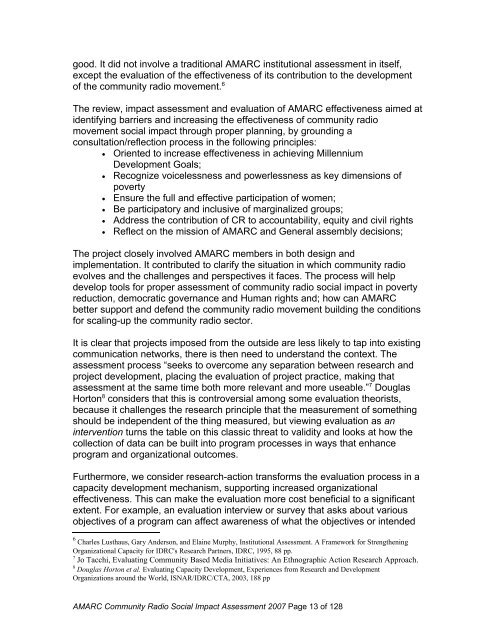Removing Barriers, Increasing Effectiveness - amarc
Removing Barriers, Increasing Effectiveness - amarc
Removing Barriers, Increasing Effectiveness - amarc
You also want an ePaper? Increase the reach of your titles
YUMPU automatically turns print PDFs into web optimized ePapers that Google loves.
good. It did not involve a traditional AMARC institutional assessment in itself,except the evaluation of the effectiveness of its contribution to the developmentof the community radio movement. 6The review, impact assessment and evaluation of AMARC effectiveness aimed atidentifying barriers and increasing the effectiveness of community radiomovement social impact through proper planning, by grounding aconsultation/reflection process in the following principles:• Oriented to increase effectiveness in achieving MillenniumDevelopment Goals;• Recognize voicelessness and powerlessness as key dimensions ofpoverty• Ensure the full and effective participation of women;• Be participatory and inclusive of marginalized groups;• Address the contribution of CR to accountability, equity and civil rights• Reflect on the mission of AMARC and General assembly decisions;The project closely involved AMARC members in both design andimplementation. It contributed to clarify the situation in which community radioevolves and the challenges and perspectives it faces. The process will helpdevelop tools for proper assessment of community radio social impact in povertyreduction, democratic governance and Human rights and; how can AMARCbetter support and defend the community radio movement building the conditionsfor scaling-up the community radio sector.It is clear that projects imposed from the outside are less likely to tap into existingcommunication networks, there is then need to understand the context. Theassessment process “seeks to overcome any separation between research andproject development, placing the evaluation of project practice, making thatassessment at the same time both more relevant and more useable.” 7 DouglasHorton 8 considers that this is controversial among some evaluation theorists,because it challenges the research principle that the measurement of somethingshould be independent of the thing measured, but viewing evaluation as anintervention turns the table on this classic threat to validity and looks at how thecollection of data can be built into program processes in ways that enhanceprogram and organizational outcomes.Furthermore, we consider research-action transforms the evaluation process in acapacity development mechanism, supporting increased organizationaleffectiveness. This can make the evaluation more cost beneficial to a significantextent. For example, an evaluation interview or survey that asks about variousobjectives of a program can affect awareness of what the objectives or intended6 Charles Lusthaus, Gary Anderson, and Elaine Murphy, Institutional Assessment. A Framework for StrengtheningOrganizational Capacity for IDRC's Research Partners, IDRC, 1995, 88 pp.7Jo Tacchi, Evaluating Community Based Media Initiatives: An Ethnographic Action Research Approach.8 Douglas Horton et al. Evaluating Capacity Development, Experiences from Research and DevelopmentOrganizations around the World, ISNAR/IDRC/CTA, 2003, 188 ppAMARC Community Radio Social Impact Assessment 2007 Page 13 of 128
















